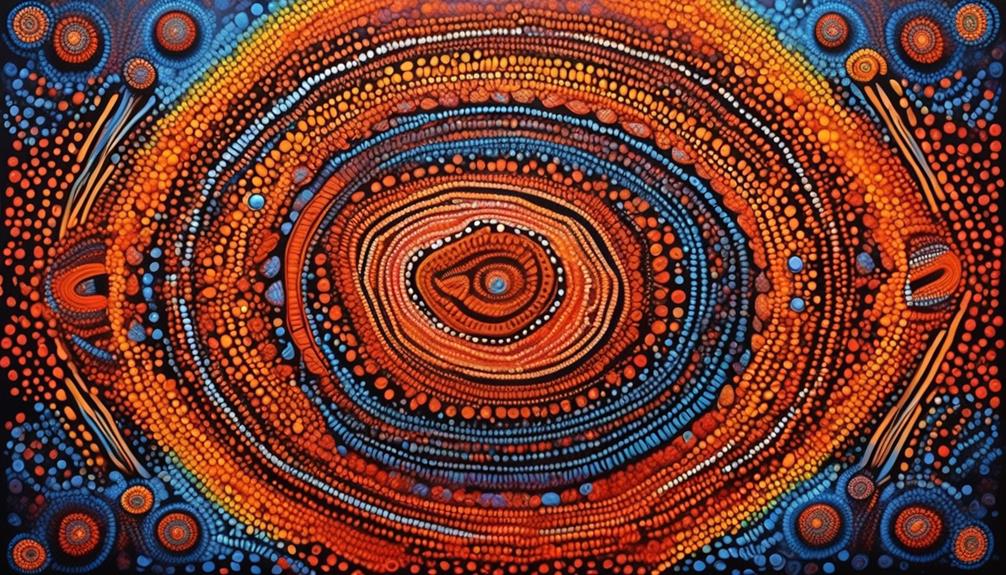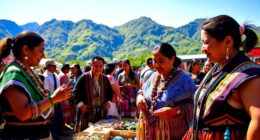Did you know that Australia is home to ancient Aboriginal rock art that remains largely unexplored, in addition to the iconic Ayers Rock?
These intriguing artworks can be found in several national parks across the country, each offering a unique glimpse into the rich cultural history of the indigenous peoples.
But which of these parks holds the key to unlocking the secrets of these ancient masterpieces?
Let's unravel the mystery together and uncover the hidden treasures that lie within these sacred landscapes.
Key Takeaways
- Kakadu National Park and Uluru-Kata Tjuta National Park are two parks where you can find Aboriginal rock paintings.
- These rock paintings offer insights into the spiritual and cultural beliefs of Aboriginal people, depicting stories of creation, ancestral beings, and the Dreamtime.
- Conservation efforts, such as monitoring and protective barriers, are in place to preserve the rock paintings in these parks.
- Other parks with Aboriginal rock paintings include Dampier Peninsula, Burrup Peninsula, Blue Mountains National Park, Flinders Ranges, and Grampians National Park.
Kakadu National Park
Kakadu National Park showcases a rich tapestry of ancient Aboriginal rock paintings, providing a fascinating glimpse into the cultural heritage of the region. These paintings, some of which are believed to be over 20,000 years old, offer a unique insight into the spiritual and cultural beliefs of the Aboriginal people. The traditional art techniques used in creating these paintings have been passed down through generations, reflecting a deep connection to the land and a profound understanding of the natural world.
The Aboriginal culture is intricately woven into every brushstroke and pigment used in these remarkable artworks. The rock paintings depict stories of creation, ancestral beings, and the Dreamtime – the period of creation in Aboriginal belief. Each painting holds immense cultural significance, serving as a visual record of the traditions, rituals, and daily life of the Aboriginal people who've inhabited this land for millennia.
The artists responsible for these masterpieces employed a range of traditional art techniques, including cross-hatching, stenciling, and using natural ochres and pigments to create vibrant colors. These techniques have been preserved and continue to be practiced by contemporary Aboriginal artists, ensuring the continuity of this rich artistic heritage.
Visitors to Kakadu National Park have the opportunity to witness these ancient wonders, gaining a deeper understanding and appreciation for the enduring legacy of the Aboriginal culture. The preservation of these rock paintings is crucial in honoring and respecting the traditions of the Aboriginal people, allowing future generations to share in the cultural wealth they embody.
Uluru-Kata Tjuta National Park
As we turn our attention to Uluru-Kata Tjuta National Park, we find a rich tapestry of Aboriginal rock paintings that offer a window into the cultural significance of this landscape.
These paintings are located in various sites throughout the park, each with its own unique stories and artistic styles.
Efforts to preserve and protect these ancient artworks are ongoing, as they continue to hold immense importance for the Aboriginal people and provide valuable insights into their heritage and traditions.
Rock Painting Locations
Located within Uluru-Kata Tjuta National Park are several significant sites containing ancient Aboriginal rock paintings, providing a glimpse into the rich cultural history of the area. These rock paintings hold deep cultural and spiritual significance, often depicting traditional storytelling themes and embodying symbolism that's central to Indigenous belief systems.
The use of Indigenous techniques in creating these artworks reflects the deep connection of the Aboriginal people to the land. The conservation of these rock art sites is of utmost importance, as they're vulnerable to environmental factors and human impacts. Efforts to preserve these paintings involve extensive research into traditional methods and materials, ensuring that the rich cultural heritage they represent is safeguarded for future generations.
The rock paintings in Uluru-Kata Tjuta National Park serve as enduring testaments to the spiritual and artistic traditions of the Aboriginal people.
Cultural Significance
Deeply embedded within the ancient rock formations of Uluru-Kata Tjuta National Park are culturally significant Aboriginal rock paintings that offer profound insights into the traditional heritage and spiritual beliefs of the Indigenous peoples. These paintings depict stories of creation, hunting practices, and spiritual ceremonies, serving as a testament to Indigenous traditions that have been passed down through generations. The preservation efforts for these precious artworks are crucial in maintaining the cultural significance they hold for the Aboriginal communities. Through collaborative initiatives between Indigenous custodians and national park authorities, ongoing preservation and conservation projects aim to safeguard these invaluable pieces of history. It is imperative that these efforts continue to ensure that future generations can continue to learn from and be inspired by the rich cultural heritage conveyed through this extraordinary Aboriginal art.
| Indigenous Traditions | Aboriginal Art Preservation Efforts | Cultural Significance |
|---|---|---|
| Stories of Creation | Collaborative preservation projects | Insights into Heritage |
| Spiritual Beliefs | Conservation initiatives | Passing Down Traditions |
| Hunting Practices | Indigenous custodian involvement | Inspirational Heritage |
Preservation Efforts
Preserving the culturally significant Aboriginal rock paintings in Uluru-Kata Tjuta National Park requires sustained collaboration between Indigenous custodians and national park authorities, ensuring the safeguarding of these invaluable pieces of history.
Indigenous involvement is crucial in the preservation efforts, as their traditional knowledge and connection to the land are essential for understanding the significance of these rock paintings.
Conservation methods such as regular monitoring, protective barriers, and environmentally friendly cleaning techniques are employed to minimize human impact and natural erosion.
Additionally, community engagement plays a vital role through educational programs that raise awareness about the cultural importance of these paintings, fostering a sense of respect and understanding among visitors.
These efforts not only contribute to the physical preservation of the rock paintings but also promote the appreciation of Indigenous culture and heritage for generations to come.
Carnarvon Gorge National Park
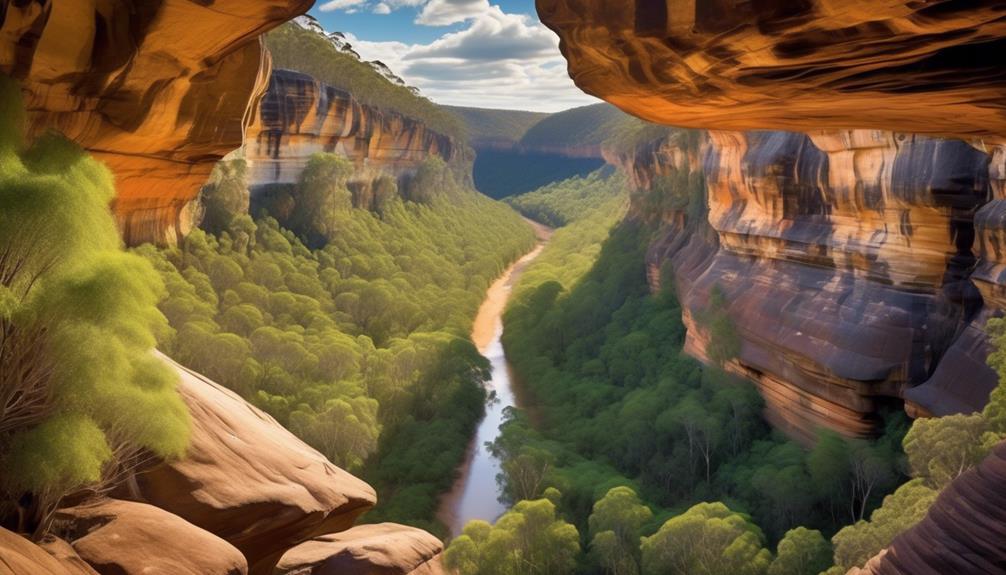
The Carnarvon Gorge National Park showcases a remarkable collection of Aboriginal rock paintings that provide invaluable insights into the rich cultural history of the indigenous people.
- Exploration opportunities: As we ventured through the rugged terrain of Carnarvon Gorge National Park, we found ourselves immersed in a world where time seemed to stand still. The park offers a myriad of trails that lead to breathtaking vistas, hidden waterholes, and of course, the ancient rock art sites. Each step is an opportunity to connect with the land and its history, making it a truly transformative experience for any explorer.
- Wildlife encounters: The rustle of leaves, the distant call of birds, and the occasional sighting of wallabies and kangaroos create an atmosphere of raw, unfiltered nature. The park is a sanctuary for a diverse array of wildlife, and the chance encounters with these creatures serve as a poignant reminder of the interconnectedness of all life. It's a place where one can observe nature unfolding in its purest form, away from the hustle and bustle of modern life.
- Cultural reverence: The rock paintings themselves are a testament to the enduring legacy of the Aboriginal people. Standing before these ancient artworks, one can't help but feel a profound sense of reverence for the culture and traditions that have persevered through the ages. Each stroke of pigment on rock tells a story, and being in the presence of such profound history is a deeply moving experience.
The Carnarvon Gorge National Park is a place of discovery, where the past and present intertwine to create an enriching tapestry of cultural and natural wonder.
Dampier Peninsula
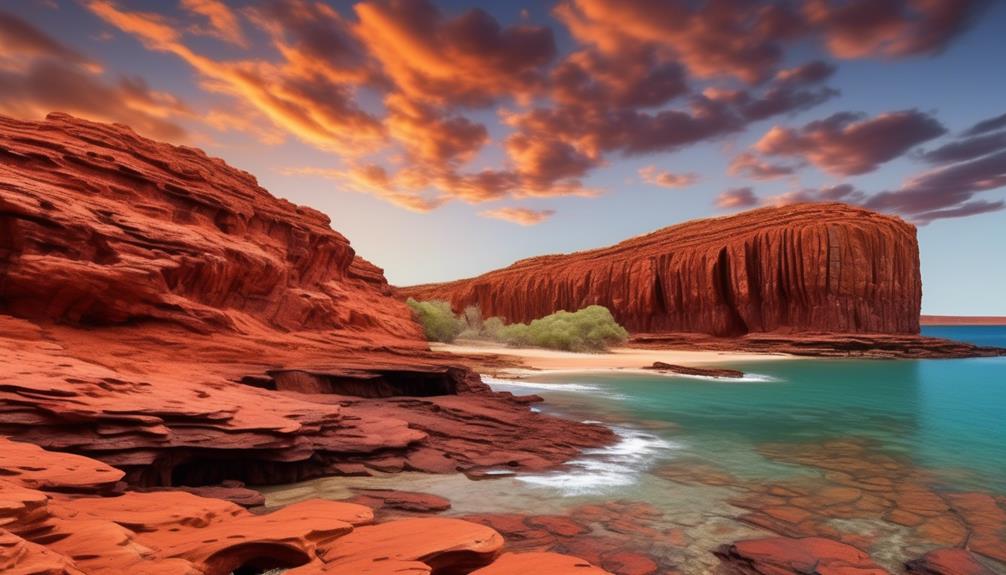
Nestled along the coast of northwestern Australia, what makes the Dampier Peninsula a significant site for Aboriginal rock paintings? The Dampier Peninsula holds immense cultural and historical significance for Aboriginal history, traditional art, and Indigenous communities. This remote and rugged landscape is home to a rich tapestry of cultural heritage preserved through ancient rock paintings, which provide a unique window into the traditions and beliefs of the local Indigenous communities.
—
| Site Name | Location | Painting Themes |
|---|---|---|
| Wary Bay | Northern Dampier | Sea creatures, hunting scenes |
| Jarlmadangah | Western Dampier | Dreamtime stories, ceremonies |
| Raft Point | Southern Dampier | Mythical beings, creation tales |
| Cape Leveque | Eastern Dampier | Totemic symbols, ancestral spirits |
—
The rock paintings in the Dampier Peninsula are a testament to the enduring connection of Indigenous communities to their land and culture. These artworks depict a wide range of themes, including Dreamtime stories, hunting scenes, mythical beings, and totemic symbols, offering a glimpse into the spiritual and everyday lives of the traditional custodians of this land. The preservation of these ancient artworks is crucial for maintaining the cultural identity and heritage of the Indigenous communities that call the Dampier Peninsula home. By safeguarding these sites, we honor the resilience and creativity of the world's oldest living culture and ensure that future generations can continue to learn from and be inspired by this invaluable cultural legacy.
Burrup Peninsula
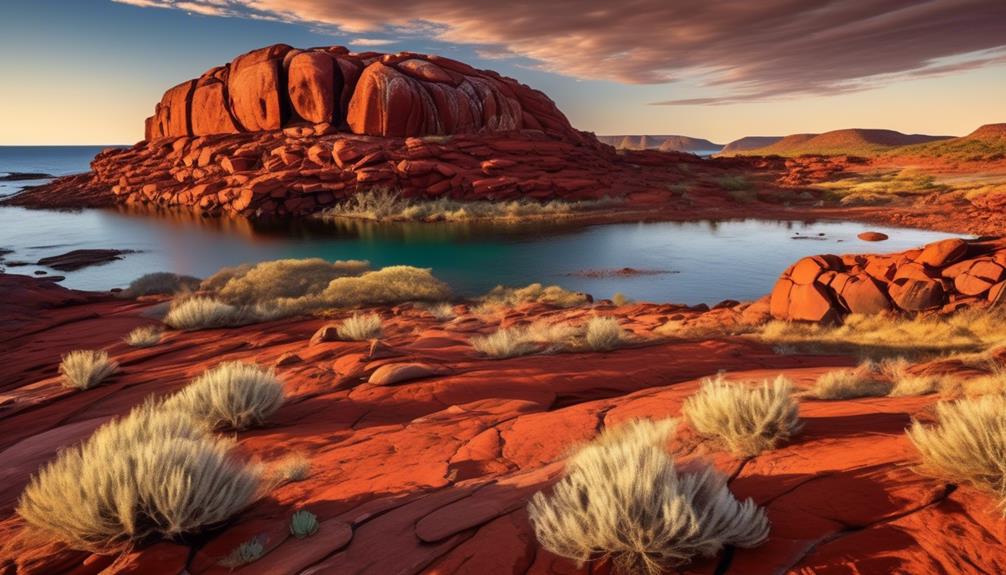
The Burrup Peninsula holds a wealth of historical and cultural significance, as evidenced by its extensive collection of ancient Aboriginal rock art. This stunning landscape is home to one of the highest concentrations of rock art in the world, with thousands of petroglyphs dating back over 30,000 years.
As we delve into the significance of this site, we invite you to consider the following emotional responses:
- Awe and Reverence: Standing amidst the rugged beauty of the Burrup Peninsula, surrounded by thousands of enigmatic rock engravings, it's impossible not to feel a deep sense of awe and reverence for the ancient Aboriginal culture that created these masterpieces. The sheer scale and intricacy of the rock art evoke a profound respect for the enduring storytelling traditions of the Aboriginal people.
- Concern and Urgency: Learning about the threats to the preservation of these invaluable cultural treasures, such as industrial development and environmental degradation, can evoke a sense of concern and urgency. The need to protect and conserve this irreplaceable heritage becomes an urgent call to action for all who value the richness of human history and culture.
- Inspiration and Connection: The vibrant expressions of Aboriginal culture through rock art serve as a wellspring of inspiration, fostering a deep sense of connection to the land and its ancient custodians. The artistry and symbolism depicted in the rock engravings ignite a profound connection to the enduring traditions and spiritual connection to the land held by the Aboriginal people.
Blue Mountains National Park

The Blue Mountains National Park is home to a rich array of Aboriginal rock paintings that hold significant cultural importance.
Preservation efforts have been ongoing to protect and conserve these ancient artworks, ensuring that they remain accessible for future generations to appreciate and learn from.
The park's rock paintings offer a unique insight into the rich cultural heritage of the Aboriginal people and the spiritual significance of the land.
Cultural Significance
With its rich history and cultural significance, the Aboriginal rock paintings in Blue Mountains National Park provide valuable insights into the traditional beliefs and artistic expressions of the Indigenous peoples of Australia. These ancient artworks, dating back thousands of years, hold profound cultural significance for Indigenous communities and offer a window into their deep spiritual connection with the land.
The vibrant colors and intricate designs of the indigenous art reflect the intimate relationship between the Aboriginal people and the natural environment, portraying stories of creation, spirituality, and daily life. The raw beauty of these rock paintings transcends time, invoking a sense of awe and reverence for the enduring legacy of the world's oldest living culture.
The preservation of these sacred sites is essential in honoring and respecting the cultural heritage of Australia's First Nations.
Preservation Efforts
Working closely with Indigenous communities, we're implementing comprehensive preservation efforts in the Blue Mountains National Park to safeguard the invaluable Aboriginal rock paintings for future generations.
Indigenous perspectives and traditional knowledge are integral to our conservation efforts. We recognize the importance of consulting with Aboriginal elders and communities to understand the cultural significance of these rock paintings and to ensure that our preservation methods align with their values and beliefs.
Moreover, we're continually assessing the environmental impact on the rock paintings, employing advanced scientific techniques to monitor any potential deterioration caused by natural elements or human activity.
Flinders Ranges
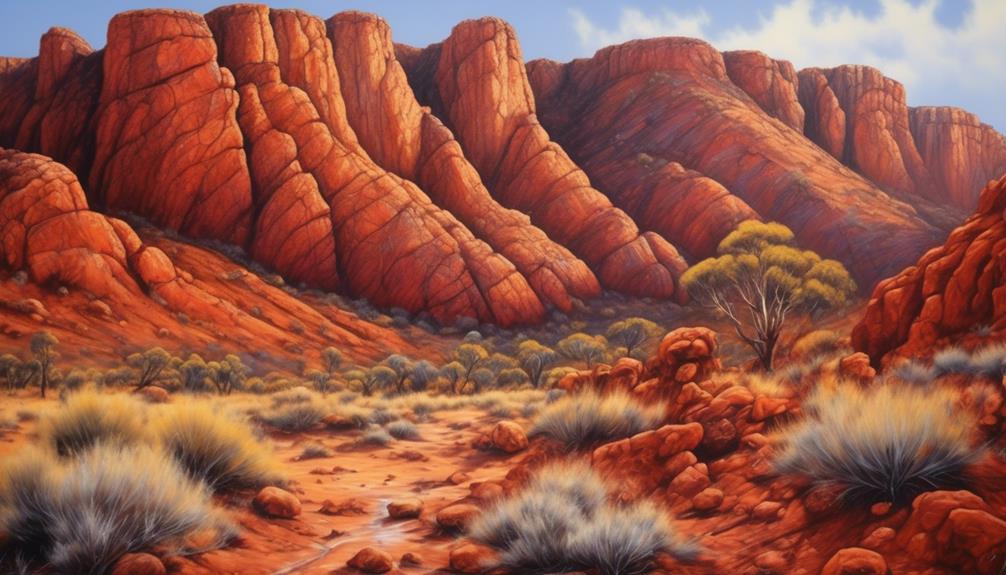
Exploring the Flinders Ranges reveals a rich tapestry of ancient Aboriginal rock paintings that offer valuable insights into the history and culture of the indigenous peoples of this region. The Flinders Ranges, with its rugged beauty and spiritual significance, holds a deep connection to the Adnyamathanha people, who've inhabited this land for tens of thousands of years.
- Awe-Inspiring Cultural Significance:
The Flinders Ranges' rock art serves as a window into the spiritual and cultural practices of the Adnyamathanha people, depicting intricate symbols, stories, and traditions that have been passed down through generations. It's a powerful reminder of the enduring presence and resilience of Aboriginal communities.
- Evolving Preservation Efforts:
Witnessing the ongoing conservation and preservation efforts to protect these sacred sites evokes a sense of hope and determination. It's heartening to see collaborative initiatives between indigenous custodians, archaeologists, and government agencies to ensure the longevity of these invaluable cultural treasures.
- Emotional Connection to Aboriginal History:
Standing in front of these ancient rock paintings, one can't help but feel a profound connection to the land and its original custodians. The Flinders Ranges' rock art serves as a poignant reminder of the deep, rich history of the Aboriginal peoples, inspiring a sense of solidarity and a commitment to honoring and preserving their heritage.
The Flinders Ranges stand as a testament to the enduring legacy of the Aboriginal people, and experiencing these rock paintings is a powerful and humbling reminder of the importance of preserving and celebrating indigenous cultural heritage.
Grampians National Park
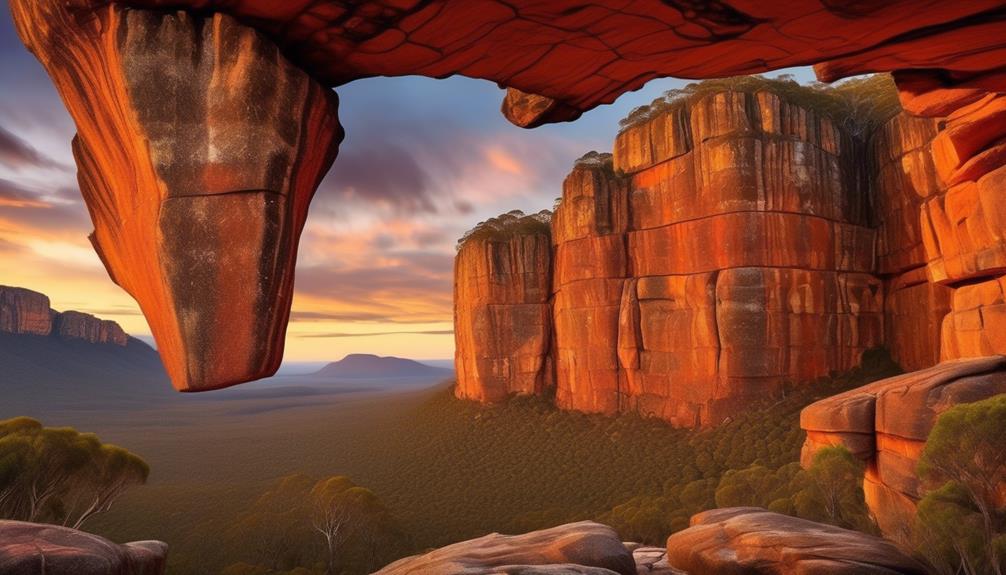
The rich tapestry of ancient Aboriginal rock paintings found in the Flinders Ranges offers valuable insights into the history and culture of indigenous peoples, and a similar treasure trove awaits exploration in Grampians National Park. The Grampians, known as Gariwerd in the local indigenous dialect, boasts an extensive collection of rock art sites that hold immense cultural significance for Aboriginal communities. These paintings, some of which are believed to be over 20,000 years old, depict stories of creation, hunting, and daily life, providing a window into the traditions and beliefs of the traditional owners of the land.
The Aboriginal cultural significance of the rock art in the Grampians can't be overstated. The paintings serve as a form of historical documentation, preserving the traditions, rituals, and spiritual beliefs of the indigenous people who've inhabited these lands for millennia. Through these artworks, traditional storytelling techniques are perpetuated, ensuring that the oral traditions and wisdom of the ancestors continue to be passed down to future generations.
Visitors to Grampians National Park have the opportunity to engage with and learn from this living cultural heritage. Guided tours led by knowledgeable Indigenous guides offer a deeper understanding of the stories and meanings behind the rock art, fostering appreciation and respect for the enduring legacy of the Aboriginal people. It's a profound experience that allows for a meaningful connection to the ancient roots of Australian culture.
Wollemi National Park
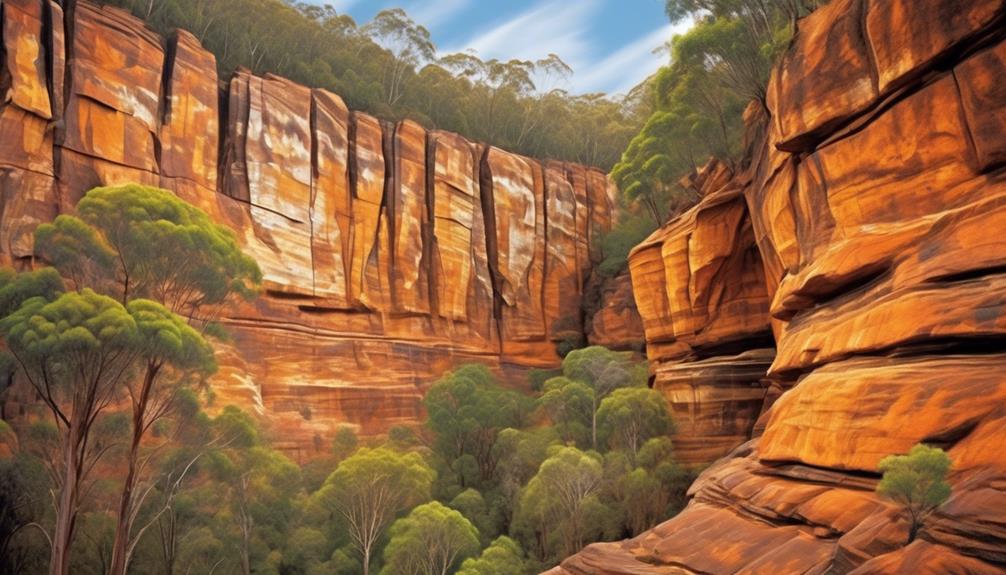
Nestled within the rugged landscapes of New South Wales, Wollemi National Park is home to a diverse array of flora and fauna, as well as an extraordinary cultural heritage represented by its Aboriginal rock art sites. The park's Aboriginal art, dating back thousands of years, holds immense historical significance, providing a window into the rich tapestry of Indigenous culture. Conservation techniques are paramount in preserving these invaluable cultural treasures, ensuring that future generations can continue to marvel at the ancient stories and traditions depicted on the rock walls.
The intricate and vivid depictions of animals, human figures, and spiritual symbols in the Aboriginal art sites evoke a profound sense of connection with the land and its ancient custodians, stirring a deep reverence for the enduring legacy of Indigenous culture.
As we stand in the presence of these awe-inspiring rock paintings, we're humbled by the resilience and creativity of the Aboriginal peoples who've safeguarded their cultural heritage for millennia, despite adversity and displacement.
The delicate and meticulous conservation techniques employed to protect these sacred sites serve as a testament to our collective commitment to honoring and preserving the cultural legacies of the First Nations, fostering a profound sense of responsibility and stewardship for these irreplaceable treasures.
Wollemi National Park stands as a testament to the enduring legacy of the Indigenous peoples of Australia, offering a glimpse into the historical significance and cultural richness of the land.
Ku-ring-gai Chase National Park
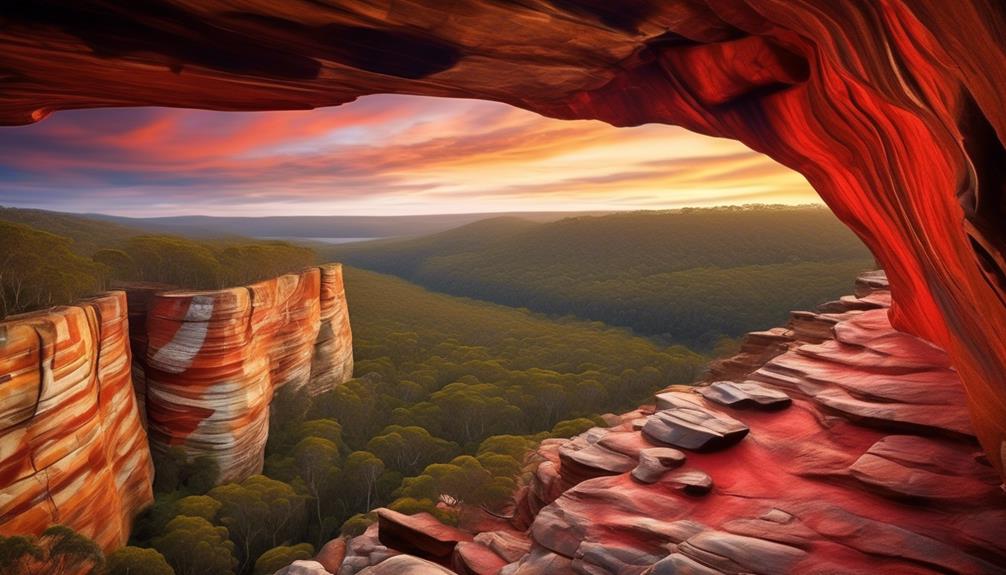
Ku-ring-gai Chase National Park, situated in New South Wales, boasts a rich cultural heritage, including captivating Aboriginal rock art sites that offer a compelling glimpse into the enduring traditions of the Indigenous peoples. The park holds significant cultural importance, as it is home to one of the largest collections of Indigenous rock engravings in Australia. These ancient artworks provide a window into the spiritual and cultural significance of the area to the local Aboriginal communities, showcasing their deep connection to the land and its history.
—
| Aboriginal Rock Art Sites in Ku-ring-gai Chase National Park | ||
|---|---|---|
| Location | Cultural Significance | Traditional Techniques |
| Red Hands Cave | Depicts hand stencils and other symbols. The site holds ceremonial significance for the local Aboriginal people. | Created using traditional methods such as blowing pigment over hands, leaving a negative impression on the rock. |
| The Basin | Features a range of rock engravings, including depictions of marine life and Dreamtime stories. | Utilized techniques such as pecking, carving, and grinding to create intricate and enduring artworks. |
| Elvina Track | Showcases a variety of engravings, including depictions of animals, human figures, and symbols. | Aboriginal artists used techniques such as pecking and grinding to create these enduring artworks. |
| West Head | Contains rock engravings illustrating fish, kangaroos, and human figures. | Artists utilized techniques like pecking and grinding to etch these enduring artworks onto the sandstone. |
| America Bay | Displays engravings of marine life, human figures, and symbols. | Created using traditional techniques such as pecking and grinding, showcasing the enduring traditions of the Aboriginal peoples. |
—
Watarrka National Park
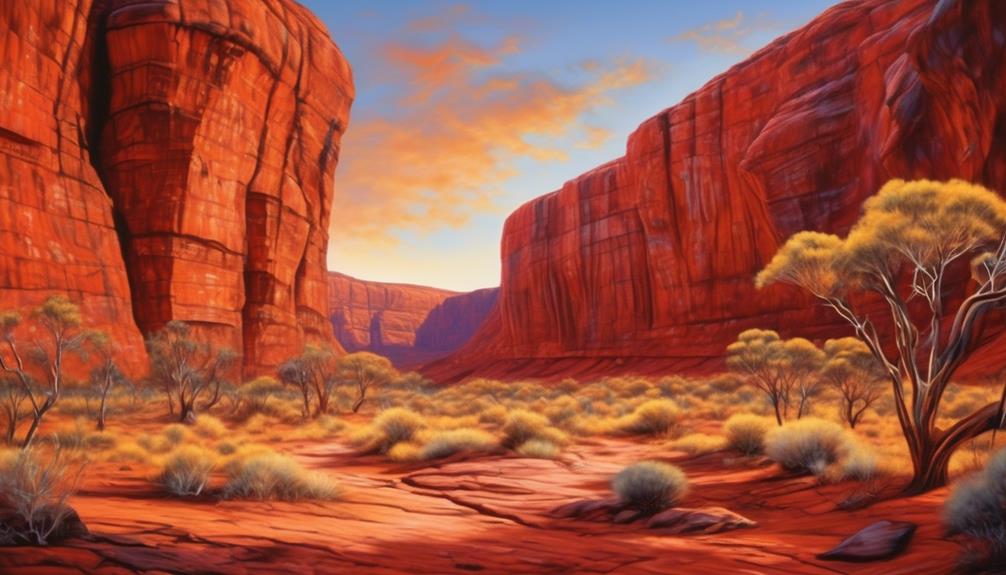
Located in the Northern Territory of Australia, Watarrka National Park is renowned for its stunning landscapes and significant cultural heritage. The park is home to a rich tapestry of Aboriginal rock art, showcasing the deep connection of the Luritja and Pertame people to the land.
As we explore the wonders of Watarrka National Park, we're captivated by the profound significance of Indigenous cultural heritage and the preservation of traditional storytelling traditions through rock art.
- The vibrant hues and intricate designs of the Aboriginal rock art in Watarrka National Park evoke a sense of awe and reverence, connecting us to the spiritual and artistic expression of the traditional custodians of the land.
- The skill and artistry displayed in the rock paintings serve as a testament to the enduring legacy of Indigenous cultural heritage, inviting us to appreciate and respect the profound depth of this ancient tradition.
- The preservation of these sacred sites is a testament to the ongoing commitment to honoring and protecting the cultural identity and ancestral history of the Indigenous communities, fostering a deep sense of appreciation and responsibility within us.
As we stand in the presence of these timeless creations, we're reminded of the importance of safeguarding and celebrating the traditional storytelling traditions that have been passed down through generations. The sacred rock art of Watarrka National Park serves as a poignant reminder of the enduring legacy of the Indigenous peoples and the intrinsic connection between culture, land, and identity.
Nourlangie Rock
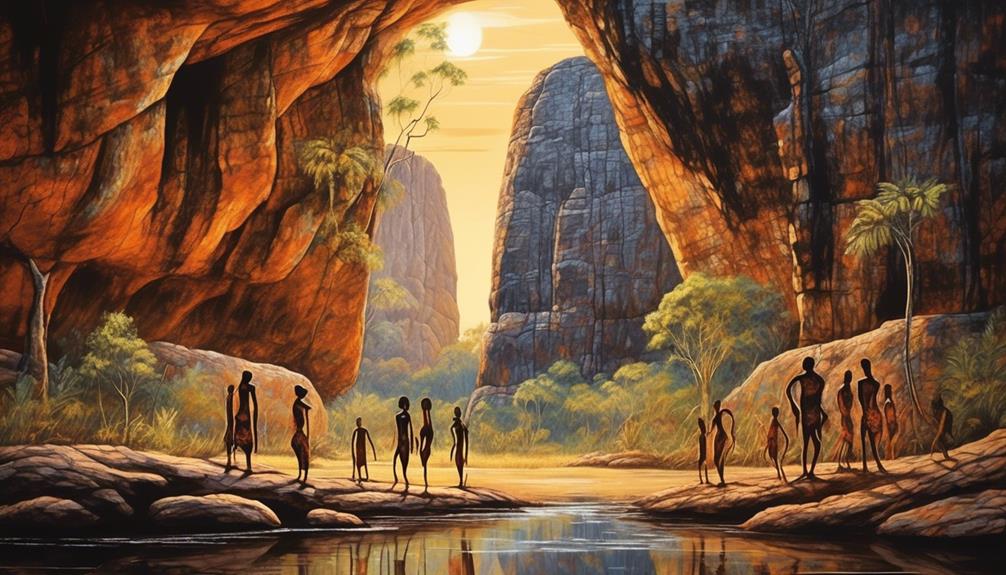
The remarkable Aboriginal rock art found at Watarrka National Park provides a compelling introduction to the cultural significance of Nourlangie Rock, a site renowned for its rich heritage and intricate rock paintings. Nourlangie Rock, located within Kakadu National Park in the Northern Territory of Australia, holds immense cultural significance for the Bininj/Mungguy people.
The rock art at Nourlangie Rock is a testament to the enduring connection of the local Aboriginal people to their land, depicting traditional stories, cultural practices, and spiritual beliefs.
The rock art at Nourlangie Rock showcases a diverse range of rock art techniques, including X-ray art, dynamic figures, and cross-hatching, reflecting the artistic prowess and cultural complexity of the Aboriginal people. These paintings aren't merely artistic expressions but serve as a repository of traditional knowledge, preserving the stories and lore of the Bininj/Mungguy people for future generations.
The cultural significance of Nourlangie Rock is further enhanced by the traditional stories associated with the site, which are intricately woven into the rock art. These stories convey the ancestral connections of the Bininj/Mungguy people to the land, their spiritual beliefs, and the natural environment. Furthermore, the preservation methods employed by the local Aboriginal custodians ensure the longevity of these ancient artworks, allowing visitors to witness and appreciate the rich cultural heritage encapsulated within Nourlangie Rock.
Nourlangie Rock stands as a living testament to the enduring traditions and cultural resilience of the Aboriginal people, offering a profound insight into their heritage and spirituality.
Ubirr
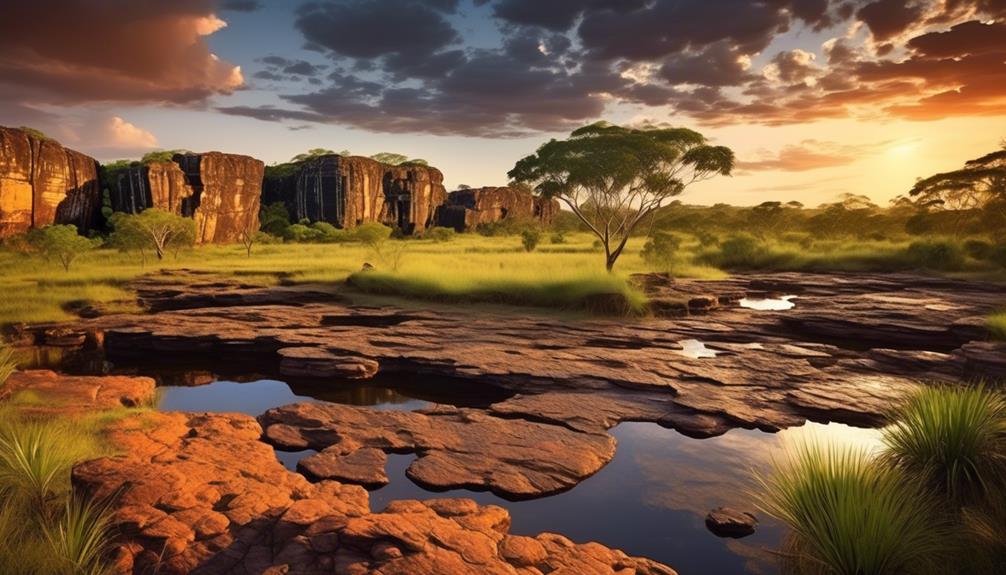
Ubirr, a significant site in Kakadu National Park, holds immense cultural and historical importance for the Aboriginal people.
The rock paintings at Ubirr provide a window into the indigenous storytelling traditions, depicting rich narratives that have been passed down through generations.
Preservation efforts at Ubirr are crucial in safeguarding these invaluable artworks for future generations to appreciate and learn from.
Cultural Significance of Ubirr
Renowned for its rich cultural heritage, Ubirr holds great significance as a site of ancient rock paintings and engravings, offering valuable insights into the traditions and beliefs of the Aboriginal people.
The cultural significance of Ubirr resonates deeply with the indigenous storytelling traditions, weaving a tapestry of connection to the land, ancestors, and spirituality.
The profound artistic expressions found in Ubirr's rock art convey a palpable sense of reverence for nature and a deep spiritual connection to the universe. These evocative depictions of ancestral beings and Dreamtime stories invite us to contemplate the enduring wisdom and resilience of the Aboriginal culture.
Visiting Ubirr evokes a profound sense of awe and respect, serving as a poignant reminder of the enduring legacy of the traditional custodians of the land.
Preservation of Rock Paintings
Situated amidst the rugged landscape of Kakadu National Park, the preservation of rock paintings at Ubirr presents a complex challenge requiring meticulous care and expertise.
Preservation techniques employed at Ubirr include regular monitoring for signs of deterioration, protective measures against environmental factors such as water and sunlight, and controlled visitor access to minimize potential damage.
Indigenous perspectives on conservation are integral to the preservation efforts, with traditional knowledge informing modern conservation practices. Collaborative partnerships between Indigenous communities and park management ensure that preservation efforts align with cultural values and practices.
Additionally, ongoing research and technological advancements contribute to the development of innovative conservation methods, further safeguarding the rock paintings for future generations.
The integration of traditional wisdom with modern conservation approaches plays a crucial role in sustaining the rich cultural heritage embodied in Ubirr's rock paintings.
Indigenous Storytelling Traditions
Immersed in the rich cultural tapestry of Kakadu National Park, the Indigenous storytelling traditions at Ubirr provide a captivating insight into the oral heritage of the region.
At Ubirr, the Indigenous storytelling techniques come alive through traditional art forms, weaving tales of creation, ancestral spirits, and the connection to the land. The experience is deeply evocative, stirring a profound sense of reverence for the wisdom passed down through generations.
Visitors are enveloped in a mesmerizing world of dreamtime stories, depicted with remarkable detail and precision on the ancient rock canvases. The storytelling traditions at Ubirr offer a poignant reminder of the enduring legacy of Indigenous culture, igniting a powerful yearning to delve deeper into these profound narratives.
The traditional art forms serve as windows into a vibrant history, inviting us to cherish and protect these invaluable cultural treasures.
Quinkan Country

In Quinkan Country, visitors can explore a rich tapestry of ancient Aboriginal rock paintings, providing a glimpse into the cultural heritage of the region. This area, located in Queensland, Australia, is renowned for its stunning rock art sites, which depict the stories, traditions, and spiritual beliefs of the Quinkan people. The Quinkan culture has a deep connection to the land, and their traditional art techniques have been passed down through generations, reflecting the enduring nature of Indigenous storytelling traditions.
—
| Key Aspects of Quinkan Country | Description |
|---|---|
| Rock Art Sites | Quinkan Country is home to numerous rock art sites, featuring intricate paintings that showcase the artistic prowess and spiritual significance of the Quinkan people. These sites serve as important repositories of Aboriginal rock art, preserving the cultural heritage of the region. |
| Quinkan Culture | The rock art found in Quinkan Country is a testament to the rich cultural traditions of the Quinkan people. These paintings offer insights into their way of life, spiritual beliefs, and connection to the land, allowing visitors to gain a deeper understanding of this vibrant Indigenous culture. |
| Traditional Art Techniques | The rock paintings in Quinkan Country are created using traditional art techniques that have been honed over centuries. These techniques involve the use of natural pigments, such as ochre, and the application of intricate designs that hold deep cultural and spiritual significance. |
| Indigenous Storytelling Traditions | The rock art in Quinkan Country serves as a visual representation of Indigenous storytelling traditions. Each painting tells a story, preserving the oral history of the Quinkan people and serving as a testament to their enduring cultural heritage. |
—
The Kimberley
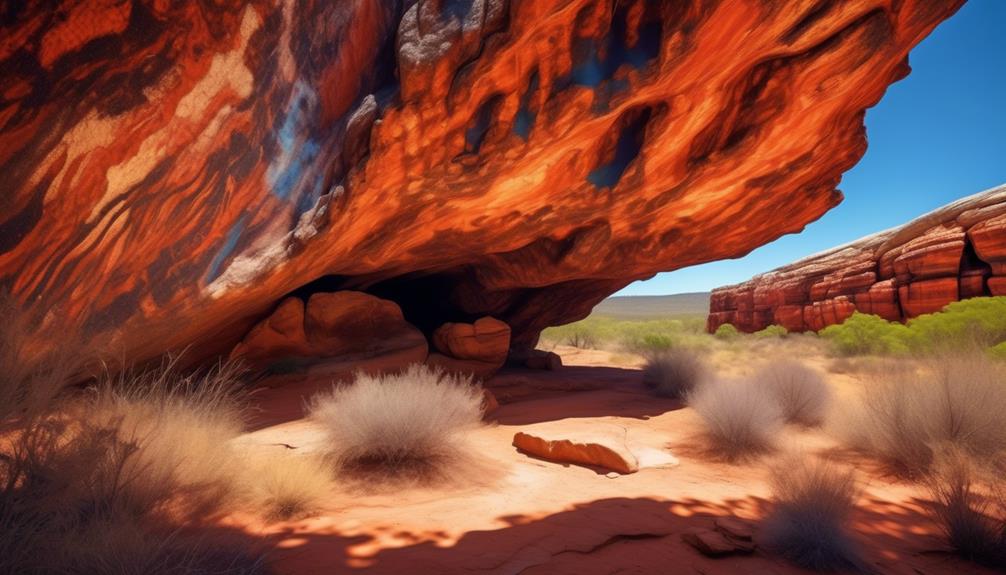
The rich tapestry of ancient Aboriginal rock paintings in Quinkan Country provides a compelling introduction to the equally captivating rock art sites found in The Kimberley region of Australia. The Kimberley is a region steeped in Indigenous art and Aboriginal history, offering a profound insight into the cultural heritage of Australia's First Nations people.
As we delve into the depths of The Kimberley's ancient rock art, we're swept away by a sense of wonder and reverence, as we're confronted with the living history of one of the world's oldest continuous cultures.
- The vibrant ochre hues adorning the rock shelters evoke a profound connection to the land, serving as a testament to the enduring relationship between the Aboriginal people and the natural environment.
- The intricate depictions of Dreamtime stories and spiritual beings etched onto the rock surfaces transport us to a realm where time holds no dominion, immersing us in the ancient wisdom and traditions of the Indigenous peoples.
- The palpable energy emanating from these sacred sites reverberates through our souls, igniting a deep sense of respect and admiration for the resilience and creativity of the Aboriginal communities that have safeguarded this cultural legacy for millennia.
The Kimberley stands as a living repository of Indigenous art and Aboriginal history, inviting us to embrace a collective consciousness that honors and preserves the rich tapestry of Australia's ancient cultural heritage.
Frequently Asked Questions
Are There Any Restrictions or Regulations for Visiting These Parks in Relation to Viewing the Aboriginal Rock Paintings?
For viewing the aboriginal rock paintings, there are certain regulations and access restrictions in place to ensure cultural education and conservation efforts. These measures are vital for preserving the historical and cultural significance of these sites.
It's important to respect and adhere to these guidelines as they're essential for the protection and preservation of these invaluable cultural treasures.
Can Visitors Book Guided Tours or Experiences Specifically Focused on Learning About the Aboriginal Rock Paintings in These Parks?
Yes, visitors can book guided tours or experiences specifically focused on learning about the Aboriginal rock paintings in these parks.
Indigenous tourism offers cultural experiences that include guided tours of Aboriginal art sites. These tours provide valuable insights into the significance and history of the rock paintings, allowing visitors to appreciate the cultural richness of the area.
It's a wonderful opportunity to learn and engage with the Indigenous heritage of the region.
Are There Any Specific Cultural Significance or Stories Associated With the Aboriginal Rock Paintings in Each of These Parks?
Specific cultural significance and stories are associated with the aboriginal rock paintings in each of these parks. The paintings often depict creation stories, hunting scenes, and spiritual beliefs, providing a rich tapestry of indigenous culture. These artworks hold immense cultural significance, reflecting the deep connection of Aboriginal peoples to the land and their enduring stories.
Conservation efforts are ongoing, and ongoing research is uncovering new insights.
What Measures Are Being Taken to Preserve and Protect the Aboriginal Rock Paintings in These Parks?
Preservation methods and conservation efforts for the aboriginal rock paintings are crucial. We implement regular monitoring to detect any signs of deterioration and apply protective coatings where necessary.
Additionally, controlled visitor access and education programs help raise awareness about the significance of these paintings, reducing the risk of damage.
We also work closely with indigenous communities to integrate traditional knowledge and techniques into our conservation strategies.
Are There Any Ongoing Research or Conservation Efforts Related to the Aboriginal Rock Paintings in These Parks?
Ongoing research into the aboriginal rock paintings in these parks continues to uncover new insights and perspectives.
Conservation efforts are also actively being pursued to ensure the long-term preservation of these culturally significant artworks.
Researchers and conservationists are collaborating to develop innovative strategies that respect the cultural and historical significance of the paintings while safeguarding them for future generations.
These efforts are vital in protecting and honoring the heritage of the Aboriginal peoples.
Conclusion
In conclusion, the Aboriginal rock paintings can be found in multiple parks, including:
- Kakadu National Park
- Uluru-Kata Tjuta National Park
- Carnarvon Gorge National Park
- Dampier Peninsula
- Burrup Peninsula
- Nourlangie Rock
- Ubirr
- Quinkan Country
- The Kimberley
These parks offer a rich and diverse experience of Aboriginal culture and history. They are a must-visit for anyone interested in experiencing the ancient art and traditions of Australia's indigenous people.
Talise is a talented writer and an expert in her field. Her unique perspective and insights enrich our content with depth and authenticity. With a wealth of knowledge and a strong connection to the subjects she writes about, Talise crafts engaging and informative articles that resonate with our readers. Her dedication to bringing Indigenous culture and wisdom to light is truly commendable.



